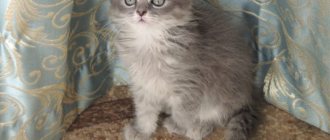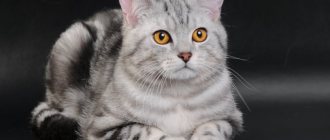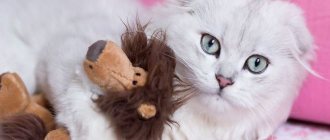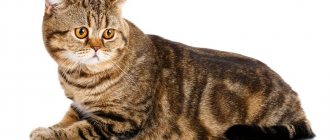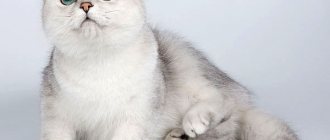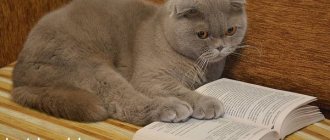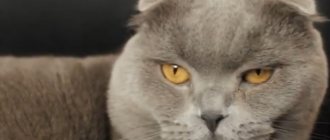A fluffy cat sits with its paws spread out imposingly, the only thing missing is the TV remote control. Straight ears and wide open eyes with a silent question. A Highland Straight representative of one of the four breeds of Scottish cats has settled at home. The pet differs from its relatives in the length and thickness of its fur, and, like a true Straight, is considered to have upright ears. What features do these animals have and how not to make a mistake when choosing a kitten: just find out the requirements of the standard and the recommendations of breeders.
Breed characteristics
The Highland Straight is an officially recognized breed. According to approved standards, Scottish Straight Longhair cats have the following characteristics.
The head is round in shape with thick fur and plump cheeks. Neat chin. Short, wide nose. Pretty face.
Representatives of the Scottish breed have large eyes. Round. The outer corners look raised up. The look always seems slightly surprised. The color of the iris is in harmony with the color of the coat. Heterochromia occurs in some individuals.
Small ears. The tips are rounded. Wider at the base. Erect. The inside is covered with thick fur.
Highland straights are considered miniature representatives of the cat family. The body is round, with well-developed muscles. The average weight of adult individuals is five to six kilograms. Males are much larger than females.
Straights' legs are short. Paws are rounded. Dense tufts of wool are planted between the toes. This feature makes the gait of animals absolutely silent.
Fluffy tail of medium length.
The standards allow any types of colors and patterns of Highland Straight coat.
Colors
In addition to the silky structure of its thick and long coat, the Highland Fold has a stunningly wide palette of colors. Conventionally, they are divided into the following groups:
- Plain. All existing options are marble, black, chocolate, blue, lilac and red. The color is solid, without marks, spots or stripes.
- Smoky. In this case, the undercoat is colored entirely light, and the tips of the guard hairs are black.
- Bicolor. The Highland Fold of this color has a variety of combinations of strictly two colors in the form of spots and markings.
- Colorpoint. The breed standard allows for acromelanism in Highland Folds. In this case, the body is painted in a light color, and the protruding parts of the body: muzzle, legs, tail, and sometimes ears are dark.
- Tabby. In this case, the cat will look like a tiger or leopard, only in a more fluffy and touching version. Any combination of colors, the main thing is a clearly readable letter “M” on the forehead.
- Tortoiseshell. Basic colors are black and red in a bizarre combination.
- Calico. Considered one of the rare ones: the lower part of the Highland Fold's body is painted white, and the upper part has different shaped spots of black and red.
History of the breed
The Scottish mountainous regions, called the Highlands, are the historical cradle of the Highland Straight breed. It was there that the distant wild ancestors of modern domestic Scottish cats lived. Hence the name of these four-legged cats.
The Scottish Straight-eared Longhair received official recognition only in the seventies of the twentieth century.
Breeding work was carried out on crossing British cats with Persians and Himalayan breeds. Breeders worked to develop a unique breed with good health and a variety of coat colors.
At first, long-haired individuals were considered a cull. They didn't pay enough attention. However, over time, breeders were still able to appreciate the unique external characteristics of the new breed of cats.
To this day, there are not many nurseries that breed Highland Straights. But those who have become the happy owners of these four-legged animals never tire of singing their praises. So the breed still has every chance to one day conquer this world.
Interaction with household members
While adults understand and accept the vulnerable nature of the Scottish cat, children do not always measure their strength in playing with the cat. Therefore, it is not advisable to leave this breed alone with children. After all, anyone can offend a cat, but not everyone can then run away from it.
Otherwise, Highlands are patient and reserved. They generously accept other pets into their hearts and onto their sofa, preferring to politely ignore such neighbors.
Among adult household members, the cat prefers to choose a “favorite” owner with whom he spends his free time. It is unlikely that you will be able to cuddle such a pet, but enjoying his company is very pleasant.
Character and psychology
Affectionate and flexible - these are perhaps the key character traits of the Scottish Straight cat. Why are they loved so immensely?
At a young age, Highland Straights are, of course, not such “couch” cats. Lovers of frolic. Such “mass people are entertainers.” Always busy either thinking about or implementing a wide variety of cat tricks.
However, already at the age of one year, straight cats mature. They calm down their childish ardor and become sort of imposing, fluffy aristocrats.
Highland Straight breeders unanimously recognize the high intelligence of their four-legged friends. Representatives of the breed quickly get used to the home routine and accept the boundaries of what is permitted. They are easy to train, enthusiastically learning the simplest commands.
The Straits are distinguished by their independence. They, of course, adore their owner with all their cat souls. But they also need to be alone from time to time.
Scottish cats are monogamous. They treat all family members kindly, but only one person becomes the love of their life. But even these mustachioed striped ones don’t stay in his arms for long. This is the nature of the breed.
What to feed?
Long-haired Scottish cats need to be given food that is intended for purebred pets. These foods contain all the necessary vitamins and nutrients. It is better not to buy cheap food, as many of them are of poor quality.
You don't want to put too much food in the bowl because cats tend to overeat. A bowl of clean water should also be freely available to the pet.
Cats can eat natural food, but you should not feed your pets human food, because the animals will have digestive problems. There is no need to suddenly change the diet; it is better to consult with the breeder.
Some owners of longhaired Scottish cats combine dry food, canned food and treats. The pet will remain healthy and their digestive system will function well.
Scottish longhair cats are the most beautiful pets with a kind and peaceful character. The main thing is to take good care of such pets and create good living conditions for them.
The character of Scottish cats is described in more detail in the video below.
How to choose a kitten
Choosing a Highland Straight kitten begins with finding a suitable cattery. At an early age, the characteristic features of the breed are hardly noticeable, which is why kids can easily be confused with young representatives of other breeds or even yard kittens.
The reputation of the nursery must be impeccable. Attention is paid to the site, reviews of previous customers, documentation, and the interior environment.
Kittens should be taken to a new family no earlier than three to four months of age. An earlier move has a negative impact on both the psychological and physical health of the furry baby.
By about twelve weeks, the baby becomes independent enough from his mother, the cat, to go to a new family. Another plus is that by this time the first vaccinations will have already been done.
Particularly scrupulous breeders try to create conditions in nurseries that are as close as possible to home ones. Animals are allowed to move freely around the area and communicate with each other. Such an atmosphere greatly facilitates the further socialization of four-legged animals.
When meeting someone, pay close attention to his appearance. Clean ears, clear eyes without discharge. Soft tummy. Shiny flowing coat with thick undercoat. A healthy baby is playful, curious, and happy to make contact.
Since the key pedigree characteristics of Highland Straights appear only at eight months, we can only rely on the conscience of the nursery owners.
Conditions of detention
You need to inquire about both the condition of the kitten and the peculiarities of its maintenance. It is worth asking the breeder about his diet. A sudden change in diet causes health problems, so it is better to leave the menu unchanged. You need to look where the tray is located and find out what kind of filler the breeder uses.
Social adaptation is important for kittens
Another point when choosing kittens is getting to know their parents. After watching them, you can imagine how the kitten will most likely grow up. You should ask the breeder about vaccinations. If you like one of the kittens, but its vaccination has not yet been completed, you should make an advance payment for the baby and wait until he gets all the vaccinations. This will subsequently protect your pet's health.
Features of care
In general, caring for representatives of the Highland Straight breed is not much different from caring for other cats. Not burdensome or specific.
Scottish Straights are clean themselves. They only need to be bathed if the pet gets seriously dirty, for example while walking outside.
For water treatments, buy a special cat shampoo for long-haired breeds for your furry friend. After bathing, the mustachioed and striped one is protected from drafts. If the cat is not afraid of a hair dryer, then it can be used to dry its fur.
Straight eyes are prone to watery eyes. They are inspected regularly. At least once a week, treat with a cotton pad or swab dipped in warm water or a special solution. Sold at any veterinary pharmacy. A separate swab is used for each eye.
Check ears once a week. Clean as needed using a soft cloth soaked in a special lotion.
To prevent tartar, your pet's teeth should be brushed. Special cat toothpaste and brush. A children's toothbrush will also work.
The four-legged furry's claws are trimmed as they grow. They are accustomed to the procedure from early childhood. Start with one claw once a week. Gradually the pet gets used to it.
Combing
The Highland Straight belongs to the long-haired representatives of the cat family. Therefore, the animal’s luxurious fur coat requires appropriate attention and care.
The basic set of cosmetic tools includes: a comb with long teeth, a brush with natural bristles, and a special furminator. Straights need to be combed at least once a week. But during the molting period you will have to switch to daily care.
A careless attitude towards your pet's fur will lead to constant problems with fur scattered throughout the apartment.
In addition, the animal develops tangles. Initially they cause physical discomfort. Afterwards, pain occurs. Mats provide an ideal environment for the development of fungal and bacterial infections, which lead to chronic dermatitis.
Experienced breeders advise starting combing with leisurely movements with the comb in the direction of hair growth. Next comes the furminator. They go in the direction of hair growth and against. Complete the procedure with a brush. With its help, the pet is given a massage and “fixed styling.”
Nuances of breeding
Breeding the breed has many difficulties, so amateurs will not master this process. To prevent an animal from being born with skeletal deformities or joint problems, it is important to check all individuals that are allowed for breeding.
Breeders usually cross pointy-eared Highland Straights with Scottish Folds. The result of mating is plump, round and funny babies. However, the percentage of kittens with a defect is very high.
To better understand the breeding process, you need to take a felinologist course. It is better for show- or breed-class cats to participate in matings. You should not buy animals younger than 6-8 months. Exterior can only be assessed in adult cats. Before this time, the individual may change color or develop genetic diseases, which will complicate the breeding of purebred individuals.
Participation in matings is possible only after 1.5 years of age. Before mating, the cat must take part in exhibitions and complete a pedigree. Otherwise, it will be impossible to register the litter, and the babies born will not be considered purebred.
Nutrition
On the one hand, Highland Straights cannot be classified as picky cats in terms of nutrition. They are omnivores. Moreover, the Scots are real gluttons. And also true admirers of the “sofa” lifestyle. Therefore, breeders should be careful about the quantity and quality of cat food.
The simplest solution is to choose ready-made food. Not lower than premium class. A suitable mixture contains at least forty percent meat. This food is balanced and contains all the microelements and vitamins necessary for your pet’s health.
This is an ideal option for people who do not have extra free time.
For breeders who have the opportunity to independently develop a daily menu, natural nutrition is suitable.
The diet is based on dietary meat. At least seventy percent. Another ten are for offal. Beef, veal, rabbit, turkey, chicken are ideal. Among cereal crops, preference is given to buckwheat and rice.
Kefir is an essential part of the Scottish Longhair's daily diet. Before serving, it is warmed to room temperature. As an alternative, use fermented baked milk or yogurt. Raw vegetables and herbs will add variety to the menu.
When feeding a pet with natural food, the animal is additionally given a vitamin and mineral complex, previously agreed upon with a veterinarian.
It is strictly forbidden to feed the Scottish Highland Straight with milk, fish, sweets, pickles, smoked meats and table food.
A prerequisite for keeping a cat is to provide access to fresh, clean drinking water.
Straights are fed two to four times a day. The serving size is calculated based on the weight, age and lifestyle of the animal.
Health
The absence of the lop ear gene has a beneficial effect on the health of representatives of the Scottish family. Indeed, unlike straights, folds relatively often suffer from problems with the musculoskeletal system.
But even straight-eared cats are predisposed to certain diseases.
Turn of the century. This is due to the relationship with Persian cats. It was from them that the straights inherited a genetic predisposition to this disease. Weakening of the muscles and ligaments of the eyelids leads to deformation of the eyelid. The cornea of the eye begins to rub against the skin and hairs. Why does it get injured over time?
The first manifestations are watery eyes, ingrown hairs, and red eyes. It is important not to miss the moment and contact a specialist in time. Otherwise, there is a high risk of losing the eye.
Hypertrophic cardiomyopathy. Another “gift” from Persian relatives. Deterioration of the heart walls leads to loss of elasticity. Blood circulation improves. The supply of oxygen and nutrients becomes difficult. At first, only an ultrasound will help identify the disease. Late stages cannot be treated. The first symptoms are shortness of breath, fatigue and fainting.
Obesity. With poor nutrition and a sedentary lifestyle, Scottish Straights inevitably develop problems with excess weight and all the accompanying ailments.
With proper care, the average lifespan of Highland Straights is about twenty years.
Interesting Facts
The long-haired straight-eared cat got its name from the mountainous terrain in Scotland, where the breed originated. The word highland translated from English means “highlands”.
Other interesting facts about Highland Straights:
- These cats have a poorly developed vestibular apparatus. When falling from a height, they do not always land on their feet. Scottish Longhairs are afraid when they are picked up and never climb to heights themselves.
- The Highland Straight gene for long hair was inherited from representatives of the Persian breed.
- Both straight-eared and fold-eared longhaired Scots are used to work with children with special needs. They are present in school classes in some European countries.
Vaccinations
Good health is an integral part of a long and happy life for a pet. It is the breeders' job to provide for it. In this matter, vaccination is on the same level as proper nutrition.
Owners of domestic cats often say that their pet does not go outside, which is why it does not need vaccinations. It's a delusion.
Pathogenic microbes and dangerous viruses easily enter the home on people’s clothes and shoes. Pets must be vaccinated. Regardless of their lifestyle!
When the kitten reaches seven to nine weeks, he receives his first vaccination. After two to three weeks, revaccination occurs. It is important to ensure that the procedure does not coincide with the period of the baby’s teeth changing. At this time, the baby’s immunity is especially vulnerable.
Further vaccination occurs on an annual basis. An individual vaccination schedule is drawn up by a veterinarian depending on the characteristics of the animal’s breed and lifestyle. Ten days before vaccination, the cat is dewormed.
In addition, you should visit the veterinary clinic in advance and make sure that your pet is healthy. After all, vaccination is a serious test for the immune system. In a weakened animal, the likelihood of severe complications increases significantly.
